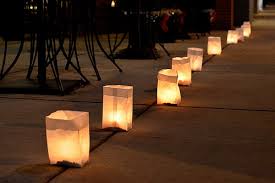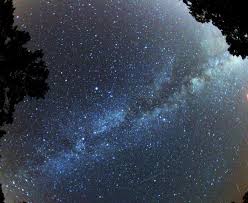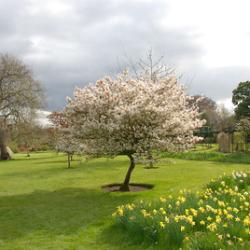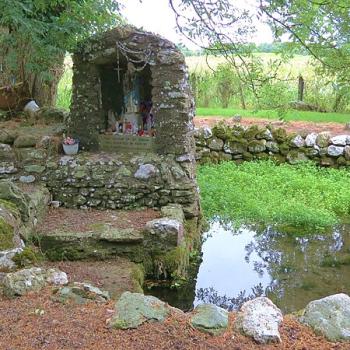…. Seek Me in the light that is in the darkness and seek Me in the darkness itself. And know that your seeking and yearning will not avail you unless you know the Mystery—that if you do not find what you seek within yourself, you will never find it without. For behold, I have been with you from the beginning and I am that which is attained at the end of desire. ~~ J. D. White after D. Valiente
On the 21st at 8:39 pm Pacific time, the sun will be as close to Earth as it will get this year. Because of the tilt of Earth, however, the Northern Hemisphere is pointed away from the sun and will have the least sunlight during the day that it will at any point this year.
Thinking of this time of darkness, I have thought of my childhood.
I learned, directly and indirectly, that the dark was a bad thing, something to be feared, something full of unknown dangers. As the Scottish poem says, “From ghoulies and ghosties / And long-leggedy beasties / And things that go bump in the night, / Good Lord, deliver us!”
The Revelations of Darkness
But there is more to the dark than just fear of the unknown. There is more to the dark than concealment. As anyone who has touched another’s skin in the dark knows, there are some things that are only revealed by darkness. Darkness, then, is not simply the absence of light, but has character all its own.
This season of darkness reminds me that it is dark and light together that make such beauty at this time of year. But the dark is the ground of the light’s being. The darkness is ascendant. This is not a time of balance.
Nonetheless, we kindle what we can. The Chanukah candles of earlier this month. The lights twinkling on houses and the trees.
The luminaria of Christmas Eve glowing in the darkness of midnight. The candles of Kwanzaa. And the moon and stars. The moon and stars of solstice, the lights of the night outside the city. The full moon coming this year on Christmas itself.
None of these “lesser” lights would be visible without the darkness. This is a cliché…light casts shadow, darkness allows the light to be seen. But it is cliché because it is true. And it is true metaphorically as well as materially.
“Seek Me in the Light in the Darkness. And seek Me in the Darkness itself,” says the Goddess.
The Romantic Dark Night of the Soul
Take, for example, the very misunderstood expression, “The Dark Night of the Soul,” from John of the Cross’ book and poem of the same name. The poem is about being led through the dark by nothing other than the kindling warmth in one’s own breast, the desire for the Beloved. Furthermore, the image is of coming to the Beloved, wrapped in the concealing embrace of the night.
The dark night of the soul, then, is not something to be feared. The dark night of the soul is the time when the soul is near, in the close and holy darkness, to the embrace of the ultimate Beloved.
There is also the darkness of the womb and the surprise of light that comes with birth. We rest within our mothers, turning gently with her movements, feeling her voice and her moods, and all those of others who come close.
So too metaphorically, religiously. The Winter Solstice is a time of deep love. It is the time of going inward to our Deepest, Wisest Selves and finding the darkness there. The close and holy, the embracing darkness. For those among us who are theists, the solstice can be a time of encountering the Divine in its most intimate form.
And Winter Solstice, like the Summer Solstice, is a turning point. The Darkness does not stay forever. Earth turns and Her tilt brings the light back to us.
Nonetheless, the Winter Solstice is not merely something to get through, any more than Summer Solstice should bring on the mourning for the dying of the light. So how might we engage Winter Solstice?
One Winter Solstice Tradition
On the 21st, my wife and I will celebrate with our Solstice traditions. We will turn the lights off to go to bed. And when we wake, we will not turn them back on. Instead, we will light candles and lanterns throughout the house. For the day, we will not have electric light. We will open the blinds to let in the wan light. And when the sun begins to set, we will honor its going down into the deepening dark.
And as we go to bed, we will not turn on a light. We will blow out the last candle and be with the darkness until the morning. There will be no light in the house. Not until the 22nd, after Earth has begun to move away from the Sun and the light has begun to return.
All our moving about in the dim helps us take in the darkness. It helps bring the darkness into ourselves. As we become more and more a part of the dark, our gaze turns inward and there are paradoxically things we can see more clearly.
As David Whyte says in his poem, “Sweet Darkness,” from his book The House of Belonging
“You must give up all other worlds
Except the one to which you belong.
Sometimes it takes darkness
And the sweet confinement of your aloneness
To realize anything or anyone
That does not bring you alive
Is too small for you.”
Darkness, paradoxically, is illuminating, even enlightening.
Become Your Own Lover
The darkness is a place where we can realize ourselves. Realize our place. Realize the contours of our own hearts. Just as the candlelit dimness of romance can bring us closer to a beloved, so too does the darkness invite each of us to become our own lover.
So this week, and especially Monday into Tuesday, I invite each of us to go into the dark. To experience it in whatever way we can. To spend some time there, and find out what we might learn. Go into the labyrinth path toward our own hearts, spend some time alone, and then return to the world, changed, renewed, restored, and ready for the light.














